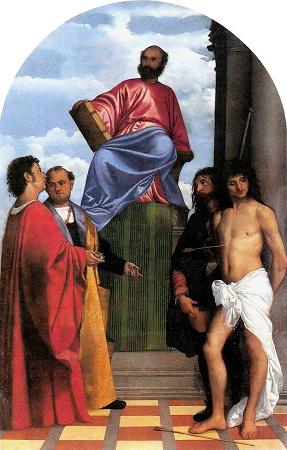Titian (1490 - 1576). Tiziano Vecelli or Vecellio, known in English as Titian, was an Italian painter during the Renaissance, considered the most important member of the 16th-century Venetian school. He was born in Pieve di Cadore, near Belluno. During his lifetime he was often called da Cadore, from Cadore, taken from his native region. Recognized by his contemporaries as The Sun Amidst Small Stars, Titian was one of the most versatile of Italian painters, equally adept with portraits, landscape backgrounds, and mythological and religious subjects. His painting methods, particularly in the application and use of colour, exercised a profound influence not only on painters of the late Italian Renaissance, but on future generations of Western art. His career was successful from the start, and he became sought after by patrons, initially from Venice and its possessions, then joined by the north Italian princes, and finally the Habsburgs and papacy. Along with Giorgione, he is considered a founder of the Venetian School of Italian Renaissance painting. During the course of his long life, Titian's artistic manner changed drastically, but he retained a lifelong interest in colour. Although his mature works may not contain the vivid, luminous tints of his early pieces, their loose brushwork and subtlety of tone were without precedent in the history of Western painting. The exact time or date of Titian's birth is uncertain. When he was an old man he claimed in a letter to Philip II, King of Spain, to have been born in 1474, but this seems most unlikely. Other writers contemporary to his old age give figures that would equate to birthdates between 1473 and after 1482. Most modern scholars believe a date between 1488 and 1490 is more likely, though his age at death being 99 had been accepted into the 20th century. He was the son of Gregorio Vecellio and his wife Lucia, of whom little is known. Gregorio was superintendent of the castle of Pieve di Cadore and managed local mines for their owners. Gregorio was also a distinguished councilor and soldier. Many relatives, including Titian's grandfather, were notaries, and the family were well-established in the area, which was ruled by Venice. At the age of about ten to twelve he and his brother Francesco were sent to an uncle in Venice to find an apprenticeship with a painter. The minor painter Sebastian Zuccato, whose sons became well-known mosaicists, and who may have been a family friend, arranged for the brothers to enter the studio of the elderly Gentile Bellini, from which they later transferred to that of his brother Giovanni Bellini. At that time the Bellinis, especially Giovanni, were the leading artists in the city. There Titian found a group of young men about his own age, among them Giovanni Palma da Serinalta, Lorenzo Lotto, Sebastiano Luciani, and Giorgio da Castelfranco, nicknamed Giorgione. Francesco Vecellio, Titian's older brother, later became a painter of some note in Venice. A fresco of Hercules on the Morosini Palace is said to have been one of Titian's earliest works. Others were the Bellini-esque so-called Gypsy Madonna in Vienna, and the Visitation of Mary and Elizabeth, now in the Accademia, Venice. A Man with a Quilted Sleeve is an early portrait, painted around 1509 and described by Giorgio Vasari in 1568. Scholars long believed it depicted Ludovico Ariosto, but now think it is of Gerolamo Barbarigo. Rembrandt borrowed the composition for his self-portraits. Titian joined Giorgione as an assistant, but many contemporary critics already found his work more impressive, for example in exterior frescoes that they did for the Fondaco dei Tedeschi. Their relationship evidently contained a significant element of rivalry. Distinguishing between their work at this period remains a subject of scholarly controversy. A substantial number of attributions have moved from Giorgione to Titian in the 20th century, with little traffic the other way. One of the earliest known Titian works, Christ Carrying the Cross in the Scuola Grande di San Rocco, depicting the Ecce Homo scene, was long regarded as by Giorgione. The two young masters were likewise recognized as the leaders of their new school of arte moderna, which is characterized by paintings made more flexible, freed from symmetry and the remnants of hieratic conventions still found in the works of Giovanni Bellini.
more...














